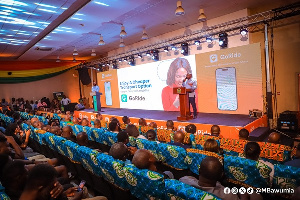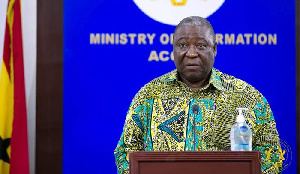- Home - News
- Polls
- Year In Review
- News Archive
- Crime & Punishment
- Politics
- Regional
- Editorial
- Health
- Ghanaians Abroad
- Tabloid
- Africa
- Religion
- Election 2020
- Coronavirus
- Photo Archives
- News Headlines
- Press Release
Health News of Friday, 29 May 2020
Source: GNA
Ghana's daily infection rate slightly decreasing - Dr Badu Sarkodie
Dr Badu Sarkodie, the Director of Public Health, Ghana Health Service (GHS), on Thursday said although the country's daily rate of new COVID-19 infections are decreasing, the curve is not sharp enough.
He said while some earlier hotspot areas such as Tema, Lower Manya and Obuasi districts have not recorded new cases of coronavirus (COVID-19) in the past week, three other hotspots have sprung up within the same period, pushing the infection curve slightly upward.
He attributed this to the fact that people were still not adhering to the preventive etiquettes and safety protocols, and advised the public to be more responsible and supportive in their behavior towards the fight against the spread of the virus in their communities.
Dr Sarkodie, who was giving Ghana's situational update of the COVID-19 pandemic at the Minister's press briefing in Accra, said official data by the GHS as at May 26, 2020 indicates that there has been 186 new infections from 31 districts in four regions since its last update on Tuesday, May 25.
He said the country's current test positivity rate is 3.56 per cent, with a cumulative total of 7,303 positive cases, 2,412 recoveries and 34 deaths.
He said this leaves the total number of active cases at 4, 857 persons, who are being managed in treatment sites, isolation centres and other home management situations; and out of these 14 were severe, but not on ventilators and three were also critically ill.
Giving details on the district update of the new cases recorded, he said, although in the Greater Accra Region 18 districts new cases, those with significant numbers were Ablekuma -47, Ayawaso East-36, Ayawaso North-11, Korle Klottey-13, and Okaikoi-six, with the remaining districts contributed about five cases or less each, while Tema metropolis also recorded four new cases.
He explained that all of them were districts who had already recorded cases and were being managed by health authorities through the existing measures, including aggressive contact tracing, treatment, isolation and intensive public education on the hygiene and safety protocols among others.
Dr Sarkodie said districts in the Eastern Region including the Akuapem North and South respectively recorded new cases, while in the Central Region, Cape Coast, Mfantseman, Abora Dunkwa and Upper Denkyira also had new record of infections.
In the case of the Ashanti Region, six districts recorded new cases and these were made up of the Kumasi Metropolis-four, Amansie West- one; Kwabre East- one; Effigya Kwabre South-one; Ejisu-one and Oforikrom-one, but Obuasi metro did not record any new cases.
He said the three new hotspots involving Obuasi, Lower Manya Krobo and Tema districts which previously spiked the number of new infections did not record any cases this time, meaning the various measures including aggressive tracing, testing, isolating, and managing cases were working.
Dr Sarkodie said ongoing actions included engagements with all stakeholders including religious organisations, Ministry of Education, Ghana Football Association and providing them with the technical support needed for to develop their own risk communication guidelines for education.
Again, enhanced surveillance, contact tracing, testing and treatment were also ongoing.
He appealed to all citizens to remain committed and disciplined in enforcing the various hygiene and safety protocols which included social distancing, wearing of face masks and regular handwashing with soap under running water, or use of alcohol-based hand sanitizers.
Entertainment

Bawumia’s $80 bn market value claim for Spotify, false!
Opinions







